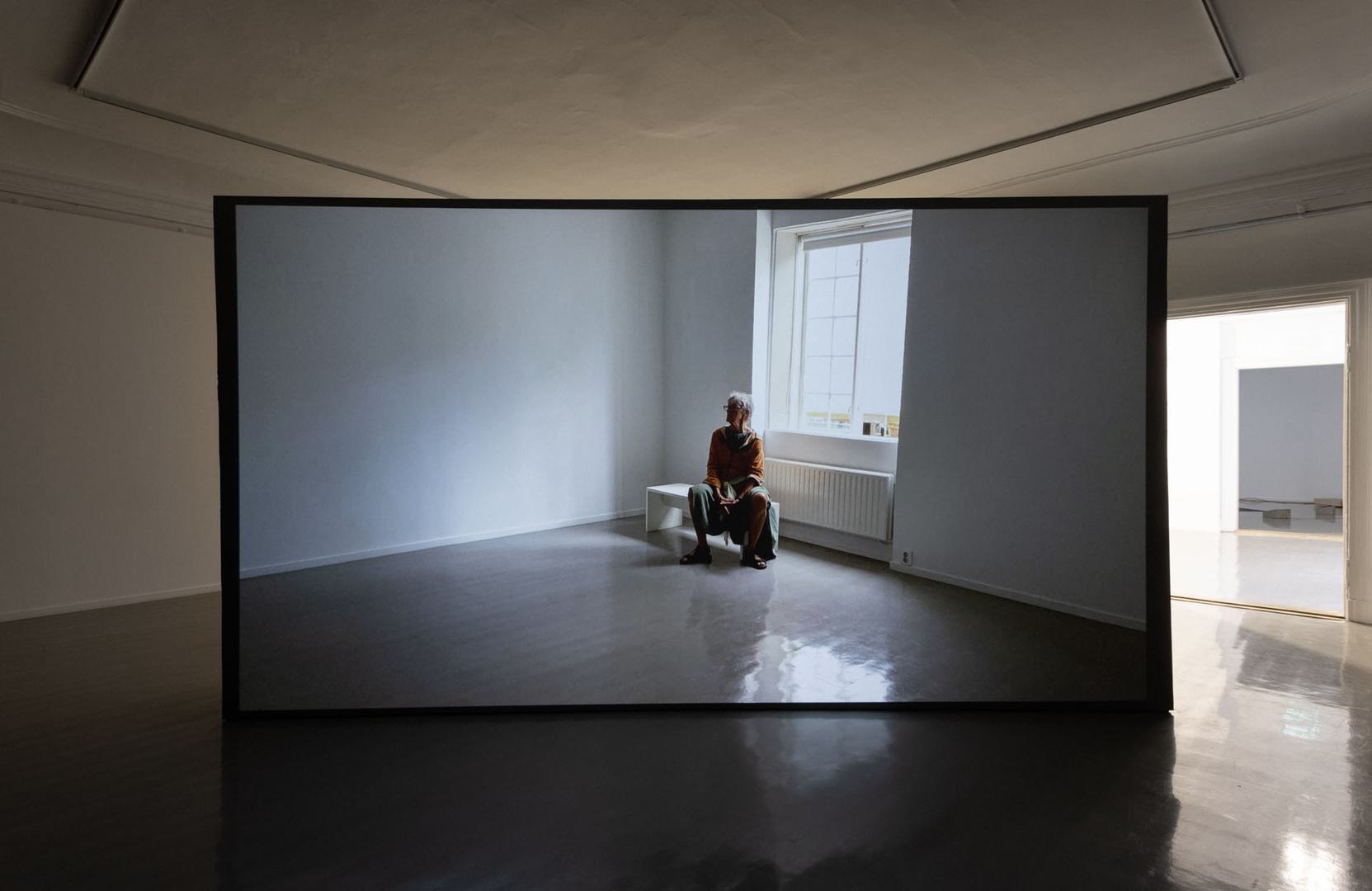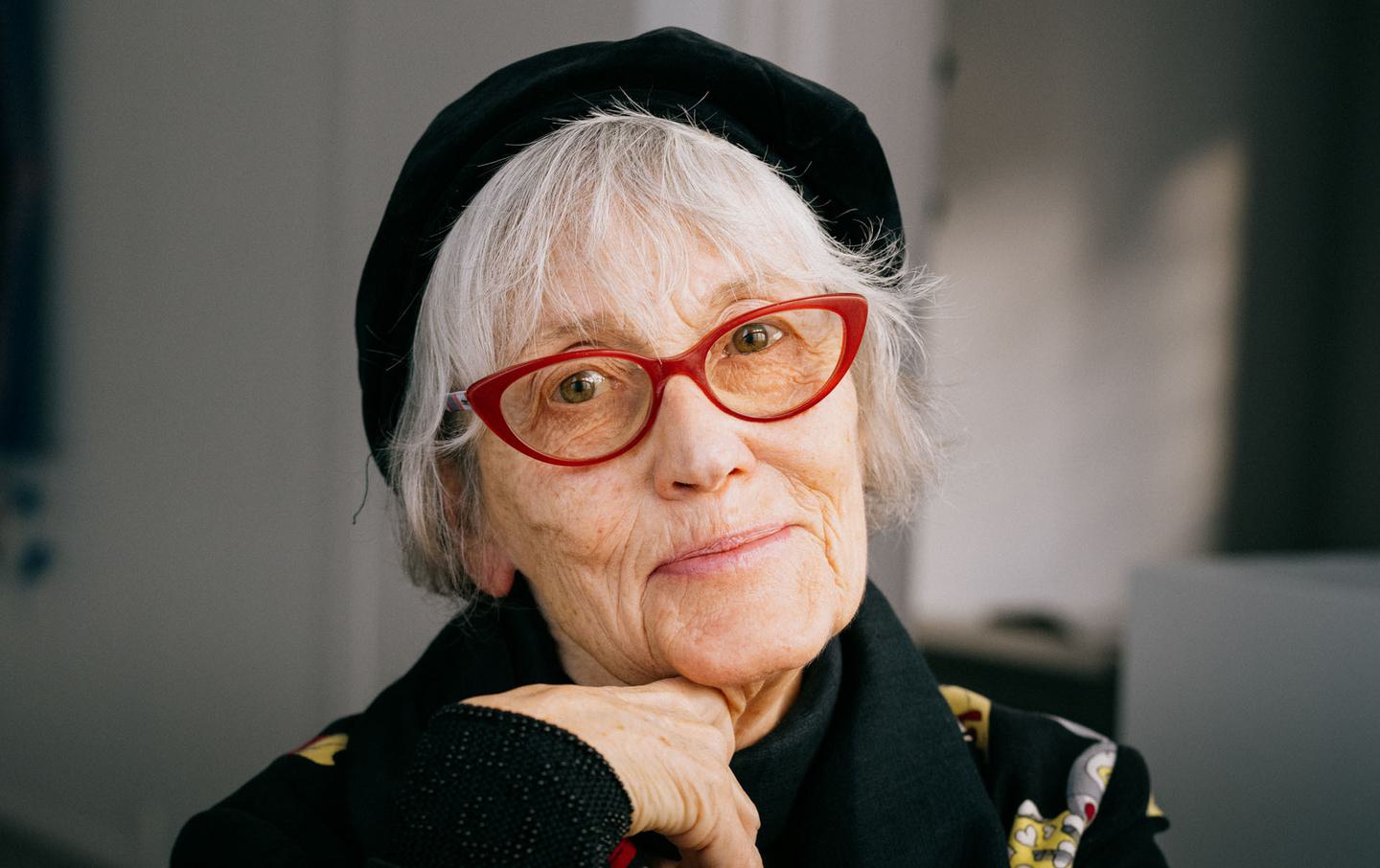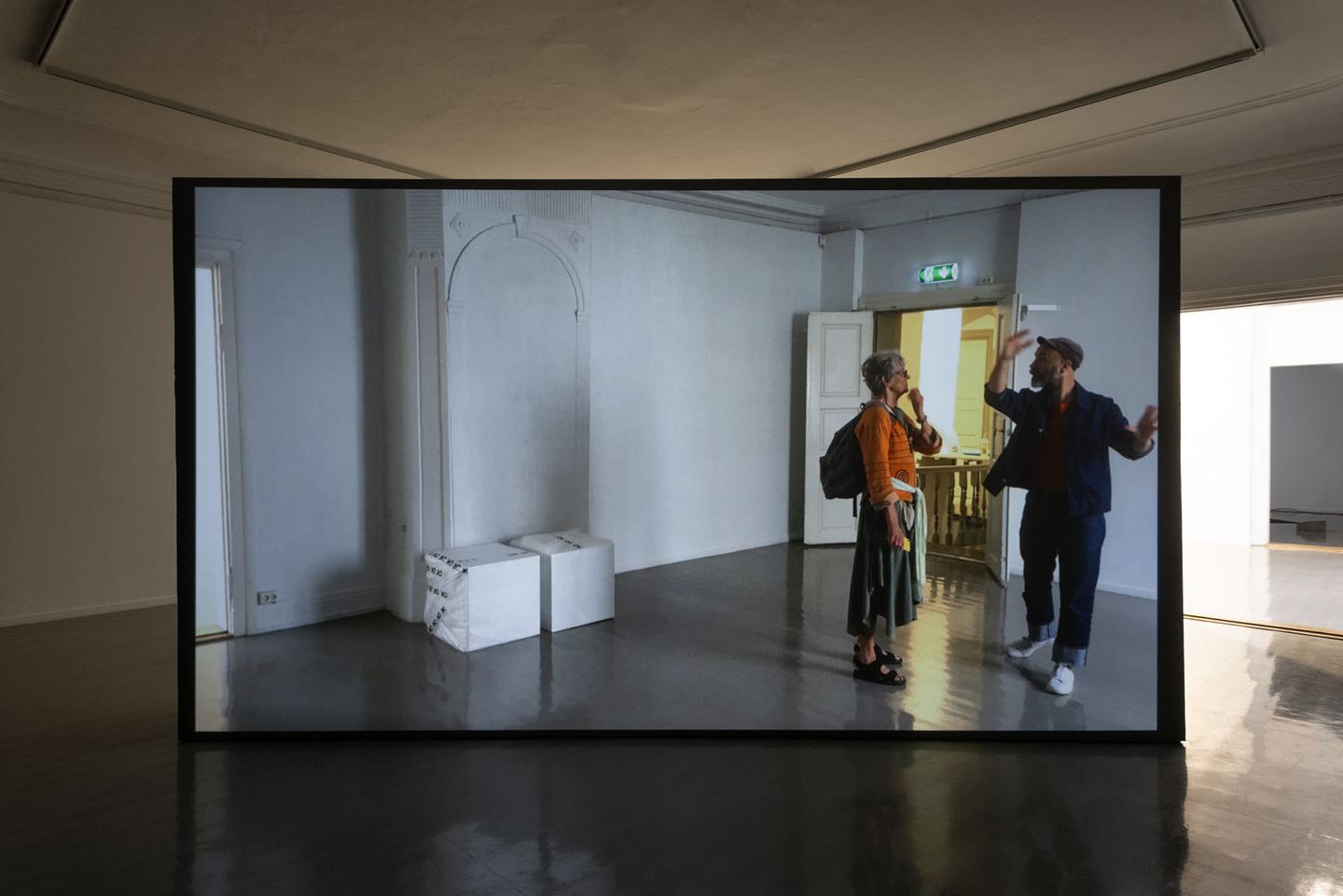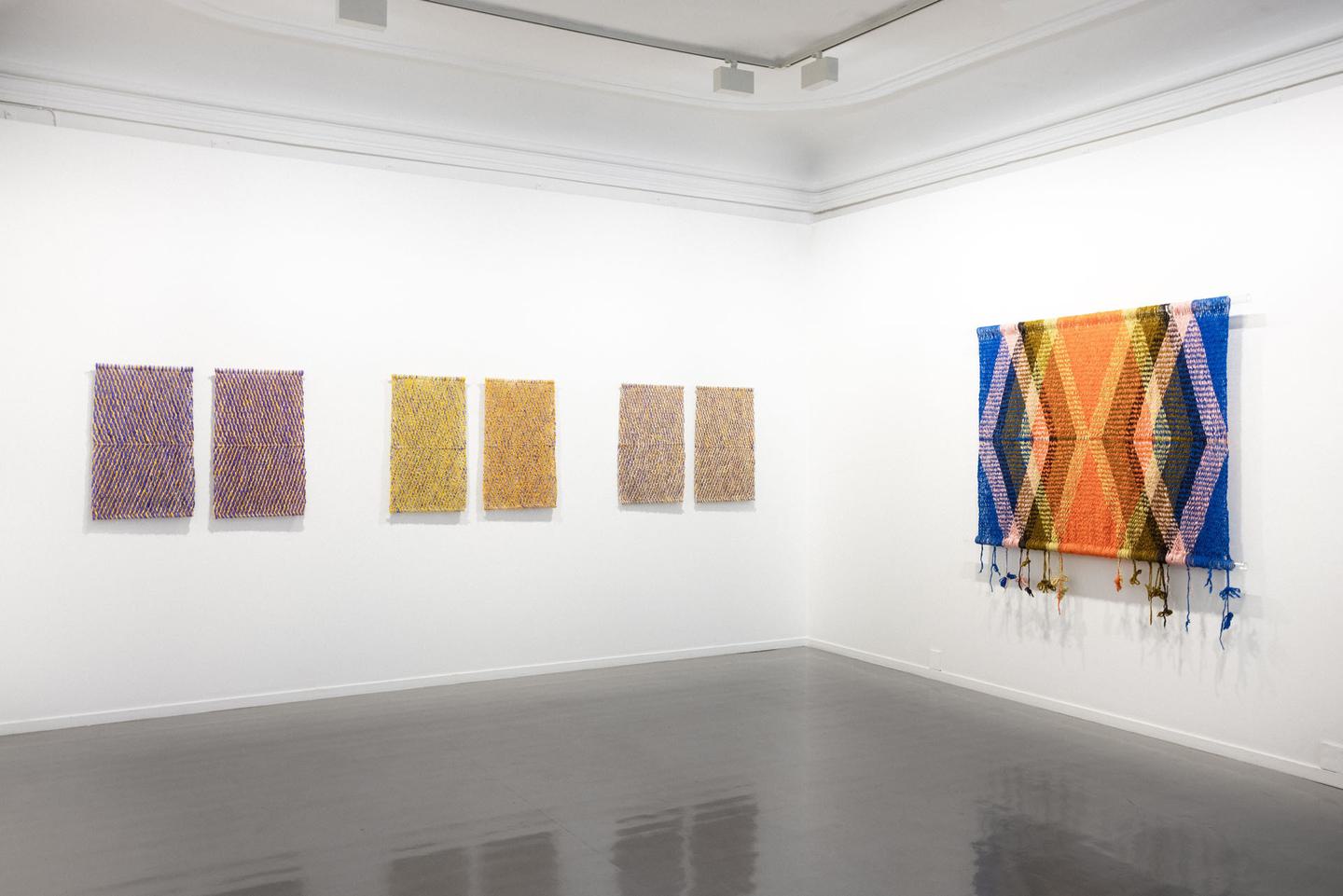Sparebankstiftelsen DNBs stipendutstilling 2021

Anne Haugsgjerd, Tanker om en utstilling, 2021. Photo: Julie Hrnčířová
Oslo Kunstforening and Sparebankstiftelsen DNB is pleased to present a grant exhibition for the fourteenth consecutive year. The three participating artists in this year’s edition are Anne Haugsgjerd, Liilian Saksi and Maia Urstad.
The Sparebankstiftelsen DNBs art grant 2021 is awarded Anne Haugsgjerd for her films Thoughts on an Exhibition (2021), More Woman, More Cry (2021) og Life in Frogner. The grant is NOK 200 000.

Anne Haugsgjerd, 2021. Photo: Julie Hrnčířová
Anne Haugsgjerd
Life in Frogner is my first film, More Woman, More Cry is my latest. They're both about me, a day or two in my life. They are about creating; the fear of failure, yes, the performance anxiety. In Life in Frogner, the protagonist is not conscious of these matters yet. Instead, the typewriter becomes the monster that destroys creativity. It stands as an obstacle between the imagination, and the finished artwork. The typewriter is like the character Bøygen in Peer Gynt. It becomes the part of yourself you must destroy in order to move forward.
Perfectionism, control, the voice in your head that says: –‘It is not good enough, people will laugh at you’. This is what the film is really about behind the external narrative, I have only now realized this after many years. A filmmaker, storyteller or painter usually does not think about subtext when she creates. Nor does she think about the audience. But as the professional analysts and therapists theorize, the artist understands more of herself and the subtext. In my second film Good Girl... Sit Down! (1991) I am guided by a psychologist through the memories of childhood. But I'm not showing this film here.
Neither do I show my penultimate film Upside Down Everything is Abstract, My Father Said (2014), which is about my father and the paintings he never exhibited. The recurring theme is again the performance anxiety, as described in a dream sequence in the short introductory film Thoughts on an Exhibition. It was important for me to repeat the theme, because it is scary to exhibit in a white cube when you are used to hiding in a dark cinema hall. Scary and exciting.
By showing my first film Life in Frogner together with my latest More Woman, More Cry, the audience can see my creative development. Has the way I make films changed? I can see similarities with my old films. For example, the fear of not having enough pictures in my last film and that the pictures are not interesting enough. But in addition to the performance anxiety, I think there is also a devilish humor there. Now I can play and take chances. This may be because I’m old. I’m no longer a sex object I’m invisible. And finally, and probably soon, death awaits, and then it really doesn’t matter. But thoughts of death also create anxiety for an atheist such as myself. You prepare yourself for what is approaching and you examine your memories. Therefore, I have chosen to reverse time by showing my youth in Life in Frogner at the end.

Anne Haugsgjerd, Tanker om en utstilling, 2021. Photo: Julie Hrnčířová
Bio
Anne Haugsgjerd (b. 1944) lives and works in Oslo. Haugsgjerd makes films which are often humorous and reflective, biographical, and self-deprecating. The films are a mixture of fiction and documentary, which was a new concept in the 1980s when she made her first film, ‘Life in Frogner’. It was shown at film festivals around the world and received the audience award at the Short Film Festival in Trondheim 1986. In 1987 it was nominated for an Amanda at the Norwegian Film Festival in Haugesund. Her second film, ‘Good Girl...Sit Down!’ was also shown internationally, including at The Kitchen in New York.
In 2014, Haugsgjerd received an award for best short documentary at Nordic Docs in Fredrikstad and the Terje Vigen award at the Short Film Festival in Grimstad for the film ‘Upside Down Everything is Abstract, My Father Said’. In 2016, Haugsgjerd, as the first Norwegian, was invited to present a comprehensive retrospective at the short film festival in Oberhausen, Germany.
In 2021, Haugsgjerd's films have been shown at the 67th International Short Film Festival, Oberhausen, where she also received honorable mention for the film ‘More Woman, More Cry’, Short to the Point, Romania, where the same film was voted best documentary, New York International Woman Festival, San Francisco Indie Festival, International Competition Tabor Film Festival, The Norwegian International Film Festival, Toronto International Woman Film Festival , Riga International Film Festival, Seoul International Senior Film Festival, International Woman's Film Festival KIN, Society for Visual Anthropology Film and Media Festival (SVAFMF), Svaneti International Film Festival.
Haugsgjerd is a graduate of the Norwegian School of Arts and Crafts (SHKS) with a diploma in graphic design. Haugsgjerd worked as a designer of magazines and books before she furthered her education through courses at the Statens Studiesenter for Film, the Dramatic Institute in Stockholm and the Danish Film School.
Liilian Saksi
Variationer av ungefärliga komplementärer (Variations of Approximate Complementaries) is a series of 12, that repeats combinations of yarns in complementary color and white. Framträdande tillbakablick (Prominent Retrospective) is made up of a single-colored yarn, in a combination of complementary and contrasting colors, where the color fields intersect in the rhombic shape that is characteristic of the technique.
In her works, Liilian Saksi uses wool dyed with synthetic pigments from her own sheep. The interaction between colors and material is a recurring theme. She often works with shades so that a kind of flicker or a friction occurs. Saksi is interested in the optical color, the one that is registered by the eye, and occurs when for example two different colors are twisted together in a yarn. She sets her own rules for the work and then alternates between being intuitive and systematic.
The expression in Liilian Saksi's sprang work is reminiscent of weaving, but instead of being built up of warp and weft, the surface is constructed of one or more continuous threads. The yarn is stretched in parallel and then braided by hand, row by row, which makes the work grow from the middle outwards. The threads cross each other on the diagonal and construct a stable surface which at the same time allows for the yarn's own expression and shape.
Liilian Saksi works with wool from the flock of sheep at her parents’ in Sweden, and from her own flock in Norway. The principle for both herds is the same, one fixed group of individuals as groundskeepers, pets, and wool producers. They all have a name, and the yarn can in principle be traced back to a specific sheep. The yarn thus also functions as a kind of portrait where the wool from each sheep has its own character and expression, both in color and materiality.
Anchoring her work to a specific place and life situation, not least the artist's relationship to sheep, is based on an interest in humankind’s relationship to other species. How the daily contact with animals affects us mentally, but also how our own values and degree of care varies depending on the type of function we think the animal has for us. These are themes that stir up mixed feelings in Liilian Saksi motivating her to work closely with the material and the individuals behind it.
For Liilian Saksi, there is also a historical perspective in her work, as the traditional craft of spinning yarn has been a necessity and a crucial technique in human history for millennia. Through wool, Liilian Saksi is reminded of a world long gone, the present and the one that lies ahead

Liilian Saksi, Variationer av ungefärliga komplementärer, 2021 og Framträdande tillbakablick, 2020. Photo: Julie Hrnčířová
Bio
Liilian Saksi (b. 1989) lives and works in Skotterud, Innlandet. In her practice, Saksi uses wool from her own flock of sheep as a raw material which is then hand spun. Her work emphasises repetition and variation in colour, pattern and texture. Saksi's technique creates a literal tension in the material and its interaction with colour. Saksi’s work is an antithesis to factory farming and industrial wool collection. By focusing on and following the animals’ needs and value, and with her increasing intimacy and closeness to the material of wool, Saksi has, since 2020 lived and worked on a small farm that is run based on the sheep’s lives and needs.
Saksi has participated in several group exhibitions including Kunsthåndverk 2017 at Nordenfjeldske kunstindustrimuseum, Trondheim; TALENT 2020 Munich; and Wonderful Everyday, dotdotdot Stockholm (2020). Solo exhibitions include Between Things at Galleri Storck, Oslo (2015); and FLOCK at SOFT gallery, Oslo (2018). Future solo exhibitions will take place at Kongsvinger Kunstforening (2022), Kunstnerforbundet i Oslo (2023) and KRAFT Bergen (2024). She has an MFA in Medium- and Material Based Art at the Oslo Academy of the Arts from 2017.
Maia Urstad
The work In the Unlikely Event of Emergency is composed of sound recordings from travels through many years, through many countries. Carefully processed and sprinkled in a room, in a city, Oslo, with a window facing the present and the story layered, floor by floor.
Diary notes from June 4, 2021: A story from a tour of the house that houses Oslo Kunstforening started a small journey in my head. A stucco ceiling from the mid- 17th century in the building's banquet hall shows various animals put together in unrated non-hierarchical order; mythic, exotic, and more local animals adorn the ceiling. They are said to represent the four corners of the world.
I'm thinking further...
The word classification becomes a trigger. The dreams are not classified. At least not mine. In my dreams, I move from a train station in Alaska to a small lighthouse on the southern coast, from a big city in Ethiopia to a bedroom on a cloud. Dreams move us without effort; we ride ants and saddle spiders.
In Oslo Kunstforening’s rooms history seeps up through the floor from the banquet hall on the ground floor, and mixes with the contemporary, with the tram and traffic outside and all the activity at street level. The hallway is the transportation stretch between the time layers, the window is the ear to the outside world, the wind carries the sound.
All the sounds of the world can seep into this room - we listen via our personal memory banks. Mine are taxi sounds in Buenos Aires, prayer calls from Ramallah, protests in the streets of Santiago de Chile, worship services in the urban space of Addis Ababa, Beffen put-putting over Vågen, the wind on Furøya and the tram outside.
Language ... sounds ... the world ...
The work also revolves around the safety information we receive as travelers. We listen with half an ear, in the clear assurance that nothing will happen, but with this murmur of imminence. In case of emergency. The danger potential is served with the softest voice, seductive. Put on your own mask before helping others. It is a floating point between everyday life, triviality, and disaster.
One snap, and life takes a different course.
In In the Unlikely Event of Emergency, the sound in the gallery space brings the corners of the world together. Through this room we can now and then hear a tram. The sound of the tram pulls us through the world. Signals and bits from different places wave in short flashes. It's like when we search the internet, or search for different stations on the radio, seek out unknown stations and new places. Accidental errors and disturbances will disrupt the soundscape. The work draws us into other times, other places, brings the world in, here, now, and is in many ways an ode to the impulses we depend on, draw on and are nourished by.

Maia Urstad, In the Unlikely Event of Emergency, 2021. Photo: Julie Hrnčířová
Bio
Maia Urstad (b. 1954) lives and works in Bergen. Urstad works at the intersection of audio and visual art. Communication technology is a recurring theme in her practice, often with the use of radio as a central auditory, visual, and conceptual element. Her works deal with different aspects of our technological development, and the soundscapes, traces, and stories we leave behind. Through site-specific sound projects, radio installations, fibre optic works in collaboration with Hilde Hauan, and other sound explorations, Urstad sends signals out into the world and draws lines both into our past and towards our future. She has been an active contributor to the Norwegian and international contemporary art scene since the mid-80s, and in 2017 was appointed as City Sound Artist of Bonn, Germany. In 2019, she was awarded the Rune Brynestad Memorial Grant, and her work MURMUR was acquired by the Norwegian National Museum in 2020.
Urstad's solo and collaborative work has been presented at The XIV Biennial of Media Art, Santiago de Chile (CL), PROA Fundación (AR), Kunsthuset Kabuso, Norsk Teknisk Museum, Bergen Kunsthall, Trafo Kunsthall Oslo, Barents Spektakel, and Lydgalleriet i Bergen (NO) Bonnhoeren (DE), Struer Tracks (DK), Lighthouse Brighton (UK), Sonic Acts (NL), Borderline Festival (GR), High Zero Festival (US), Singuhr Sound Gallery (DE), Moderna Museet (SE), The 5th Marrakech Biennial (MA), KODE - Bergen Art Museum (NO), Johannesburg Art Gallery (SA), Prefix ICA in Toronto (CA), and Electrohype, Malmö Konsthall (SE).
About the jury
Jury leader is Behzad Farazollahi, visual artist and founding member of MELK. The remaining members are Randi Grov Berger, visual artist and founder of Entrée, Marianne Hultman, artistic director of Oslo Kunstforening; Mike Sperlinger, writer, curator and professor of theory and writing at the Oslo National Academy of the Arts and Elise Storsveen, visual artist.
Background
Since 1986 Oslo Kunstforening has held a competitive exhibition and awarded a stiped, with the kind support of Sparebanken Oslo og Akershus.
Since 2008, Sparebankstiftelsen DNB and Oslo Kunstforening have awarded grants to Ellisif Hals and Susanne Skeide (2008), Ignas Krunglevičius (2009), Ann Cathrin November Høibo (2010), Kaia Hugin (2011), Marie Buskov (2012), Sandra Mujinga (2013), Ingrid Lønningdal (2014), Andrea Bakketun and Christian Tony Norum (2015), Tor Børresen (2016), Emilija Škarnulytė (2017) and Eirik Sæther (2018), Germain Ngoma (2019), Berivan Erdogan, Hanni Kamaly and Kjetil Skøien (2020).